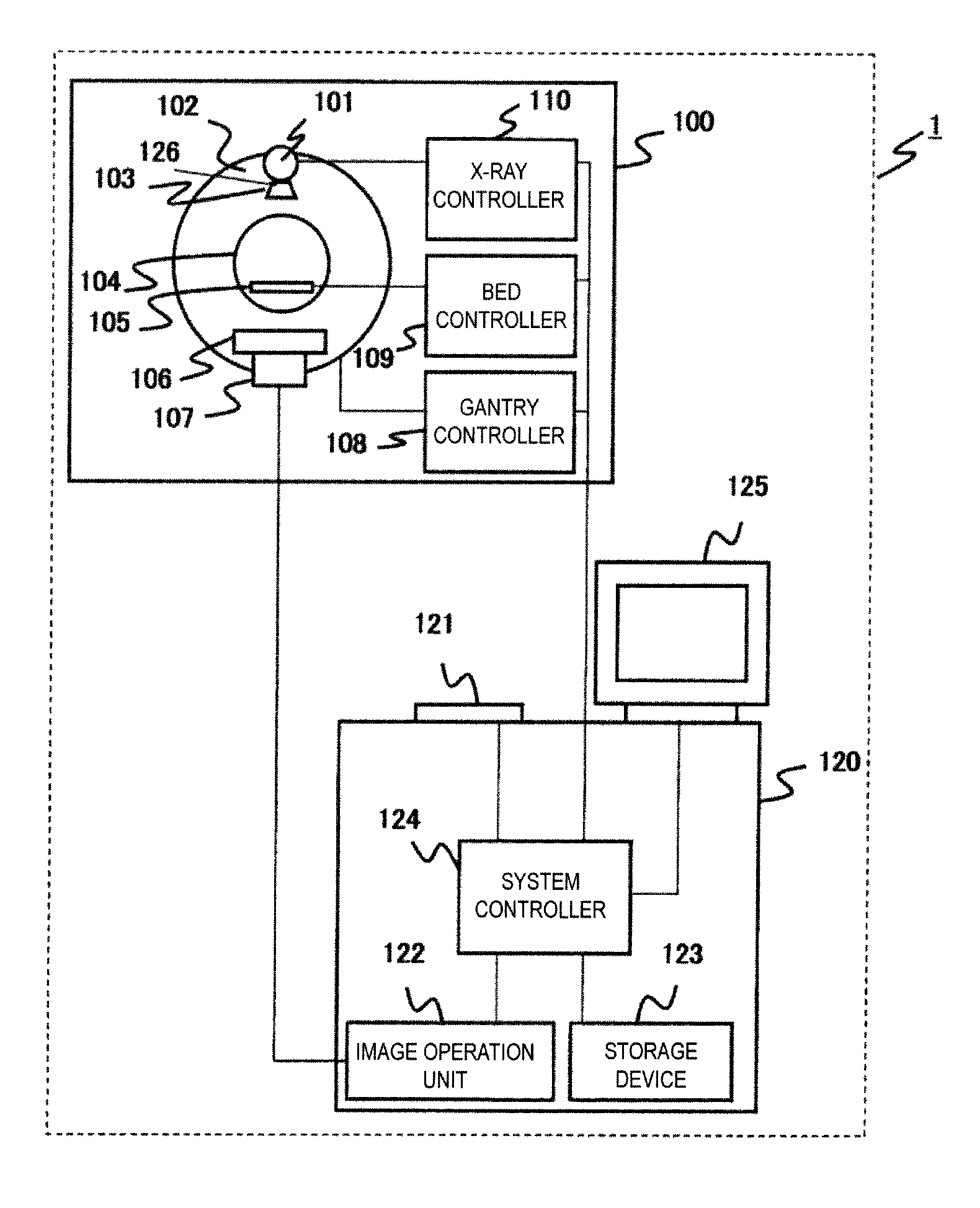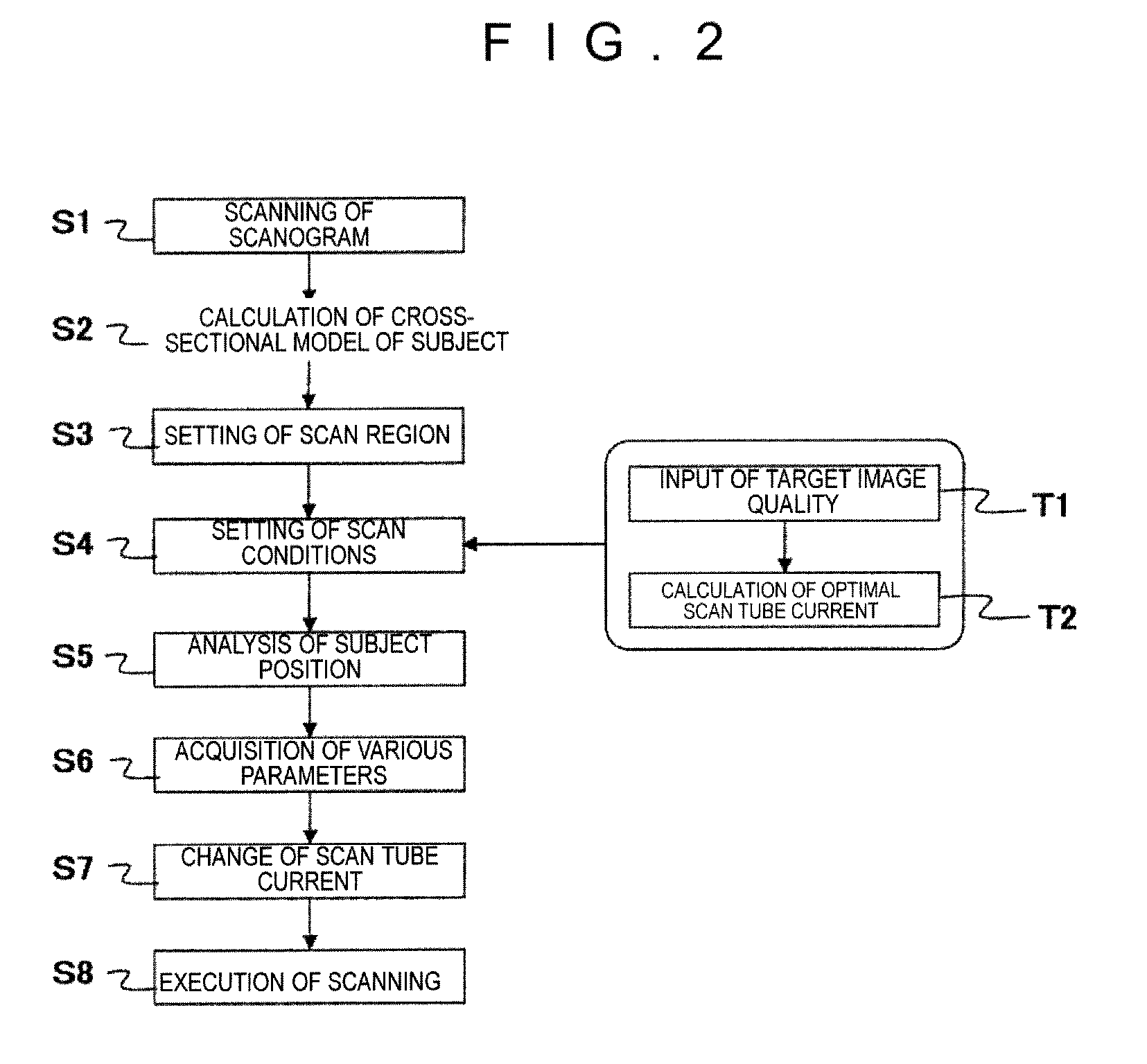X-ray CT apparatus and method
a technology of ct and x-ray, applied in the field of ct apparatus, can solve the problems of excessive or deficient x-ray amount, and achieve the effect of high-quality
- Summary
- Abstract
- Description
- Claims
- Application Information
AI Technical Summary
Benefits of technology
Problems solved by technology
Method used
Image
Examples
first embodiment
[0041]FIG. 2 shows a flow chart of a series of operations in scanning (scanning) related to a first embodiment of the present invention. Hereinafter, each step in FIG. 2 will be described in the order of the steps.
(Step S1)
[0042]The X-ray CT apparatus 1 acquires the scanogram projection data by performing scanogram scanning of the subject under control of the system controller 124 and creates a scanogram image. X-rays are emitted to the subject in one direction (for example, from the back to the front) without rotating the X-ray tube, and the scanogram projection data is acquired by the detector. The X-ray CT apparatus 1 creates a scanogram image by transmitting the scanogram projection data to the image operation device 122 and displays it on the display device 125. This scanogram image is created when an image of X-rays transmitted from the back to the front is viewed from one direction, for example.
(Step S2)
[0043]Then, the scanogram projection data is analyzed by a cross-sectiona...
second embodiment
[0075]Next, a second embodiment will be described using the operation flow chart in FIG. 7. The operation flow in the second embodiment is basically the same as that in the first embodiment. However, in the case of a bed of an X-ray CT apparatus used in the present embodiment, not only horizontal movement (301) in the body axis direction of the subject and vertical movement (302) as in the related art are possible as shown in FIG. 8(a), but also left and right movement (303) in the body width direction of the subject is possible as shown in FIG. 8(b).
(Step S1) to (Step S6)
[0076]Steps S1 to S6 are the same processing as in the first embodiment. However, in step S6, it is necessary to newly acquire a parameter X0. X0 is an initial position of the bed in the left and right direction.
(Step S9)
[0077]In step S9, the optimal bed position is calculated on the basis of the parameter acquired in step S6. First, the optimal bed height is expressed as (Y0−εV). Here, εV is given by Expression 3,...
third embodiment
[0085]Next, a third embodiment will be described using the operation flow chart in FIG. 10. The operation flow in the third embodiment is for explaining an operation only in normal scan in which a bed (subject moving unit) is moved every slice for scanning. Basically, the third embodiment is the same as the first and second embodiments, but the operation after acquisition of various parameters is different.
(Step S1) to (Step S6)
[0086]Steps S1 to S6 are the same processing as in the second embodiment.
(Step S13)
[0087]In step S13, the bed position is changed so that the amount of displacement acquired in step S6 becomes 0 at the first slice position in the corresponding sequence.
(Step S14)
[0088]In step S14, scanning of 1 slice is executed at the bed position changed in step S13.
(Step S15)
[0089]In step S15, the bed is moved to the next slice position in the body axis direction. Then, the process proceeds to step S13, and the process of steps S14 and S15 is performed by the number of sli...
PUM
 Login to View More
Login to View More Abstract
Description
Claims
Application Information
 Login to View More
Login to View More - R&D
- Intellectual Property
- Life Sciences
- Materials
- Tech Scout
- Unparalleled Data Quality
- Higher Quality Content
- 60% Fewer Hallucinations
Browse by: Latest US Patents, China's latest patents, Technical Efficacy Thesaurus, Application Domain, Technology Topic, Popular Technical Reports.
© 2025 PatSnap. All rights reserved.Legal|Privacy policy|Modern Slavery Act Transparency Statement|Sitemap|About US| Contact US: help@patsnap.com



